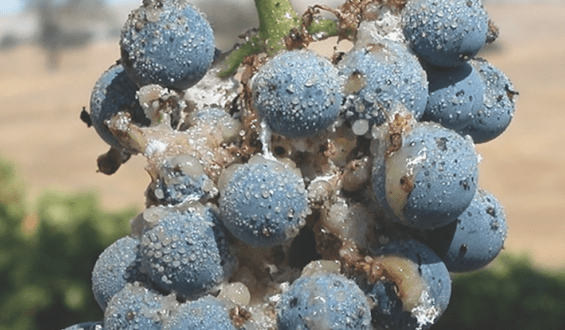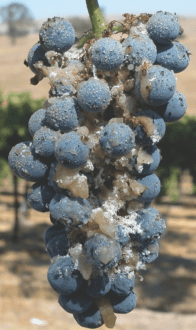

Dec 23, 2019California grape growers deal with mealybugs without chlorpyrifos
So scratch chlorpyrifos, but California winegrape growers have more tools left in the war chest for dealing with vine mealybugs.
Native grape mealybugs are usually kept in place by natural controls and parasitoids, said George Zhuang, a Fresno County viticulture farm advisor with the University of California Cooperative Extension – an exception is when Argentine ants have protected them. Vine mealybugs, however, are an invasive species and much more disruptive.
“Vine mealybug feeds on all parts of grapevine and produces so much honeydew that it makes the grapevine wet, dark and shining,” Zhuang said. “The most damage from vine mealybug is the infestation on clusters, although the spreading of leafroll virus can be also devastating through vine mealybug.”
Distinguished from other mealybugs by its lack of a tail, vine mealybugs have been found in most grape-growing regions in California.


“The vine mealybug generation number per year depends on the temperature. Central coast can have 3-5; Fresno area can have 6-7; southern SJV, e.g., Bakersfield, can have 7-8; and Coachella can have 10-12.”
Zhuang gave an example of a generic treatment plan:
- Dormant season: Chlorpyrifos (Lorsban).
- After bud break: Buprofezin (Applaud), clothianidin (Belay), imidacloprid (Admire), spirotetramet (Movento).
- Mating disruption (dispenser or sprayable formulation).
- Postharvest: Spirotetramet (Movento).
Chlorpyrifos, an organophosphate, remains federally registered with the EPA as a pesticide. But some health organizations have associated it with detrimental health effects on the human nervous system. The use of almost all pesticide chlorpyrifos in California will cease in 2020 after the state’s Department of Pesticide Regulation reached an agreement with pesticide manufacturers.
Chlorpyrifos was used for pest control with a wide variety of specialty crops, including winegrapes – although applications largely dropped off in recent years as California began to restrict its use. According to a 2017 pesticide use report, its application in California dropped sharply in 2011. In 2015, it was made a restricted material, but it continued to be used for large vine mealybug populations.
Zhuang said growers are adopting other methods of controlling the bugs.
“Usually when you found infestation on clusters, it is already late for the treatment, and it might take one or two years to control the population,” he said. “The current pest control program can be effective against vine mealybug; however, its effectiveness relies on the early scouting and proactive management. … the target is to have no physical damage on clusters and limit the leafroll virus spreading. However, it might take years to completely eliminate vine mealybug.”
Zhuang also recommends having good sanitation of workers, equipment, plant materials, to educate farmworkers about vine mealybug, and to practice “vineyard vigilance,” by scouting and pheromone trap.
“Growers can also release biological products, e.g., parasitoids and predators, into the vineyard, although the effectiveness of biocontrol can be variable,” he said. “Pheromone dispensers and sprayable microencapsulated formulation (different from pheromone trap), e.g., CheckMate VMB-F, can be also effective on vine mealybug control, especially the sprayable formulation that might be more cost effective.”
— Stephen Kloosterman, associate editor














